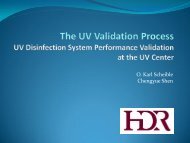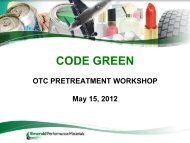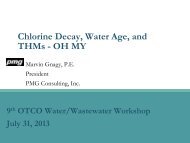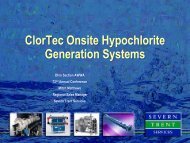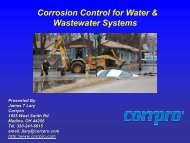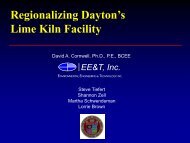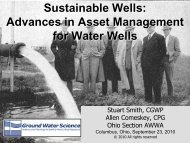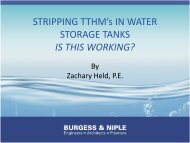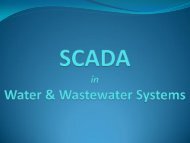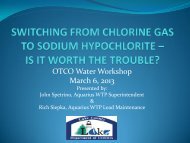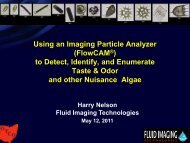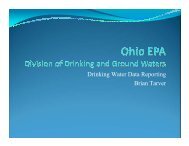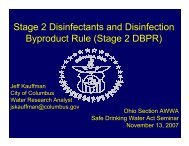Cost Effective use of UV-Peroxide for Geosmin and ... - Ohiowater.org
Cost Effective use of UV-Peroxide for Geosmin and ... - Ohiowater.org
Cost Effective use of UV-Peroxide for Geosmin and ... - Ohiowater.org
You also want an ePaper? Increase the reach of your titles
YUMPU automatically turns print PDFs into web optimized ePapers that Google loves.
<strong>UV</strong>-<strong>Peroxide</strong> <strong>for</strong> Taste <strong>and</strong> Odor<br />
Control at Aqua PA’s 15 MGD<br />
Neshaminy Water Treatment Plant<br />
John F. Civardi, Vice President, HMM<br />
Marc Lucca, VP Production, Aqua PA<br />
Ohio American Water Works Association<br />
Annual Conference<br />
September, 2010
Its all about You<br />
The unification <strong>of</strong> speaker <strong>and</strong> listener<br />
is actually an extension <strong>and</strong><br />
enlargement <strong>of</strong> ourselves <strong>and</strong> new<br />
knowledge is gained from it<br />
‣ M. Scott Peck – The Road Less Traveled <strong>and</strong><br />
Beyond
Outline<br />
‣ Describe Existing Neshaminy WTP Process<br />
‣ Describe Improvements to Clarification <strong>and</strong><br />
Residuals H<strong>and</strong>ling Systems<br />
‣ Historical <strong>Geosmin</strong> <strong>and</strong> MIB Concentrations<br />
‣ Desktop Evaluation <strong>of</strong> T&O Options<br />
‣ <strong>UV</strong>-<strong>Peroxide</strong> System<br />
‣ Construction <strong>and</strong> Startup
Overview <strong>of</strong> Aqua PA<br />
‣ Subsidiary <strong>of</strong> Aqua America<br />
‣ Publically traded (NYSE: WTR)<br />
‣ Operations in 14-states serving 3-million people.<br />
‣ Aqua PA – SE Operations<br />
‣ Serves 350,000 customers in portions <strong>of</strong> the 5<br />
counties surrounding the City <strong>of</strong> Philadelphia<br />
‣ 8 Surface WTPs <strong>and</strong> 70 Wells<br />
‣ Total Delivered Water: 100 - 140 MGD
Case Study Neshaminy WTP<br />
‣ Neshaminy WTP<br />
‣ 15 MGD max day<br />
‣ Source Water: Neshaminy Creek<br />
‣ Serves ~ 40,000 customers in Bucks &<br />
Montgomery counties; 335,000 people live in the<br />
watershed.
Case Study Neshaminy WTP<br />
‣ Watershed<br />
‣ Drainage area is about 200 mi 2 ; 53% green space; 34%<br />
agriculture; <strong>and</strong> 11% developed;<br />
‣ Possible sources <strong>of</strong> contamination:<br />
‣ Treated/untreated sewage;<br />
‣ Reservoir algal contamination;<br />
‣ Urban/Reservoir/Ag Run<strong>of</strong>f;<br />
‣ Industrial Facilities; l<strong>and</strong>fills; <strong>and</strong><br />
‣ Spills & Vehicle Accidents
Case Study Neshaminy WTP<br />
‣ 1905: Original WTP operations constructed<br />
‣ Neshaminy Creek dam & headworks; <strong>and</strong><br />
‣ Pumping station & Transmission Main.<br />
‣ 1950’s Filters & Washwater Tank<br />
‣ 2003 Clearwell <strong>and</strong> HS Pumps
Case Study Neshaminy WTP<br />
‣ Conventional Treatment<br />
‣ Design Capacity: 15 MGD Max Day<br />
‣ Clarifier: 6 - 8hrs detention time<br />
‣ S<strong>and</strong>/Anthracite filtration<br />
‣ Lignite PAC is <strong>use</strong>d<br />
‣ Sludge Lagoon/drying beds<br />
‣ Solids Disposal in On-Site Mon<strong>of</strong>ill<br />
‣ 1 On-Site Super; 1 Utility; 1 Operator 4;<br />
<strong>and</strong> 1 Laborer
Operating Plan - 2006
Neshaminy<br />
Creek<br />
Intake, Screening<br />
& Raw Water Pumping<br />
Mixing<br />
Basins<br />
Coagulation<br />
Basin<br />
Low Lift<br />
Pumps<br />
PAC<br />
8 Hrs. Detention<br />
Sludge<br />
Transfer<br />
Pit<br />
Sedimentation<br />
Sludge Lagoon<br />
(Lagoon No. 1)<br />
Clearwell<br />
Pumps to<br />
Distribution<br />
Washwater Transfer Pit<br />
8 Gravity Filters &<br />
Clearwell<br />
Washwater Drying Lagoons<br />
(Lagoons Nos. 2 & 3)<br />
Existing Plant Schematic
Proposed Neshaminy WTP<br />
Improvements Project<br />
‣ Phase I - Installation <strong>of</strong> <strong>UV</strong>-<strong>Peroxide</strong> AOP (2010)<br />
‣ Phase II – Pretreatment & Solids H<strong>and</strong>ling (2012)<br />
‣ Replace Sedimentation Basin with Plate Settler with<br />
detention time <strong>of</strong> 45 min; <strong>and</strong><br />
‣ Replace mechanical dewatering facility including Belt<br />
Presses will replace the Lagoon No. 3.
Neshaminy Site<br />
New Residuals Facility<br />
Sedimentation<br />
Basin<br />
Filter Building<br />
Clearwell<br />
Intake
T&O at Neshaminy<br />
‣ Taste <strong>and</strong> odors consist primarily <strong>of</strong> the odorcausing<br />
compounds, 2-methylisoborneol (MIB)<br />
<strong>and</strong> <strong>Geosmin</strong>.<br />
‣ The typical odor threshold is 10 ng/L <strong>for</strong> <strong>Geosmin</strong><br />
<strong>and</strong> 4 ng/L <strong>for</strong> MIB.<br />
‣ T&O occurs seasonally generally between May<br />
<strong>and</strong> September with episodes ranging from a few<br />
days to several weeks.
T&O at Neshaminy from 2006 – 2008<br />
<strong>Geosmin</strong><br />
MIB<br />
Maximum 240 45<br />
4/15/2006 6/13/2006<br />
90 th Percentile 37 8<br />
95 th Percentile 55 11
Raw Water Quality (2009)<br />
‣ Turbidity<br />
‣ Raw TOC<br />
‣ Filtered TOC<br />
830 NTU Max. 14 NTU Avg.<br />
8.0 mg/L Max. 3.6 mg/L Avg.<br />
2.8 mg/L Max. 2.0 mg/L Avg.
<strong>Geosmin</strong><br />
‣ CAS # 197000-21-1<br />
‣ Molecular <strong>for</strong>mula C 12 H 22 O<br />
‣ Primary Odor: earthy<br />
‣ Secondary Odors: musty, corn, beet like<br />
‣ Odor Threshold 5-10 ng/L<br />
‣ Produced by many blue green algae as<br />
well as actinomycetes (filamentous<br />
bacteria)
MIB<br />
‣ 2-Methyl-2-bornanol<br />
‣ Abbreviations MIB<br />
‣ CAS # 2371-42-8<br />
‣ Properties<br />
‣ Molecular <strong>for</strong>mulaC 11 H 20 O<br />
‣ Odor Threshold 4 ng/L<br />
‣ Musty smell<br />
‣ Some algae, particularly blue-green algae<br />
(cyanobacteria) such as Anabaena, produce MIB<br />
together with other odorous chemicals such as<br />
geosmin.
What is to Be Done<br />
‣ Reduced detention would result in lower<br />
removals with PAC<br />
‣ Evaluated PAC Contact Tank <strong>and</strong> AOP
Impact <strong>of</strong> Reduced Detention Time<br />
‣ Removal <strong>of</strong> up to 90% <strong>Geosmin</strong> & MIB is<br />
desired at maximum plant capacity<br />
‣ Aqua <strong>and</strong> Carbon Supplier per<strong>for</strong>med jar<br />
tests with <strong>Geosmin</strong> to assess :<br />
‣ Potential competitive effects <strong>of</strong> alum on<br />
carbon usage<br />
‣ Optimum type <strong>of</strong> PAC<br />
‣ Optimum dose <strong>and</strong> detention time
PAC Testing Results<br />
‣ Dosing PAC together with alum results in<br />
significantly lower MIB removal (28%<br />
removal Alum/PAC vs 55% PAC then alum)<br />
‣ PAC should be added prior to alum<br />
‣ Optimum/Minimum PAC detention time is 45<br />
minutes<br />
‣ Min./Max. PAC dosage is 30 mg/L - 60 mg/L
Plant Impacts <strong>of</strong> Testing<br />
‣ 45 Minutes <strong>of</strong> Detention Time at 15 MGD<br />
requires at 500,000 gallon pre-carbon contact<br />
tank with mixers<br />
‣ 30 mg/L dosage results in an additional 3,800<br />
ppd <strong>of</strong> Dry Solids<br />
‣ This would double the plant solids production<br />
<strong>and</strong> require additional residuals treatment<br />
equipment<br />
‣ Dispose <strong>of</strong> residuals in Quarry
Neshaminy<br />
Creek<br />
Intake, Screening<br />
& Raw Water Pumping<br />
PAC<br />
PAC Contact Tank<br />
In-Line<br />
Mixers<br />
(Typ. <strong>of</strong> 2)<br />
2-Stage Flocculation<br />
(Typ. <strong>of</strong> 3)<br />
Plate Settler Unit w/ Chain & Flight<br />
Sludge Collectors (Typ. <strong>of</strong> 3)<br />
To Mechanical<br />
Dewatering<br />
Clearwell<br />
Pumps to<br />
Distribution<br />
Washwater Transfer Pit<br />
8 Gravity Filters &<br />
Clearwell<br />
Washwater Drying Lagoons<br />
(Lagoons Nos. 2 & 3)<br />
PAC Contact Tank Option
<strong>Cost</strong>s Associated with PAC Option<br />
‣ Capital <strong>Cost</strong>: $2.2 million<br />
‣ Operating <strong>Cost</strong>: $310,000/yr<br />
‣ Equivalent Uni<strong>for</strong>m Annual <strong>Cost</strong>: $475,000<br />
per year (20 yrs@ 4%)<br />
‣ Note Operating cost is based on a unit<br />
PAC cost <strong>of</strong> $0.95 per pound <strong>and</strong> 90-days<br />
per year at 12 MGD <strong>and</strong> does not include<br />
solids disposal costs.
Is AOP an option
AOP 101<br />
‣ AOPs are based on generation <strong>of</strong> hydroxyl<br />
radical (OH . ) intermediates.<br />
‣ AOPs include the application <strong>of</strong> ozone,<br />
hydrogen peroxide, <strong>and</strong> ultraviolet light,<br />
either individually or in combination O 3 /<strong>UV</strong>;<br />
H 2 O 2 /<strong>UV</strong>; <strong>and</strong> O 3 /H 2 O 2 /<strong>UV</strong>.<br />
‣ Creation <strong>of</strong> OH . by <strong>UV</strong><br />
<strong>UV</strong> + H 2 O 2 2HO .
Is AOP an option<br />
‣ Per<strong>for</strong>med desktop evaluation<br />
‣ Contacted Trojan, Calgon, <strong>and</strong> Wedeco<br />
‣ Evaluated capital, operating <strong>and</strong> lifecycle<br />
costs <strong>and</strong> compared to PAC option<br />
‣ Wedeco reactors are LPHO <strong>and</strong> space<br />
was not available <strong>for</strong> the reactors<br />
‣ Ozone AOPs not feasible due to cost <strong>of</strong><br />
generators <strong>and</strong> size <strong>of</strong> generators
Desktop Evaluation (cont)<br />
‣ If Ozone was being <strong>use</strong>d <strong>for</strong> DBP control<br />
then Ozone-AOP would have merited<br />
additional consideration<br />
‣ <strong>UV</strong>-<strong>Peroxide</strong> using medium pressure<br />
reactors were compact <strong>and</strong> <strong>use</strong>d a<br />
maximum 5 mg/L <strong>of</strong> peroxide
<strong>Cost</strong>s Associated with AOP<br />
‣ Capital <strong>Cost</strong>: $2.5 million<br />
‣ Operating <strong>Cost</strong>: $200,000/yr<br />
‣ Energy<br />
‣ <strong>Peroxide</strong><br />
‣ Lamp Replacement<br />
‣ Chlorine <strong>for</strong> Quenching<br />
‣ Equivalent Uni<strong>for</strong>m Annual <strong>Cost</strong>: $384,000 per<br />
year (20 yrs@ 4%)<br />
‣ Note Operating cost is based on a unit 90 days<br />
per year at 12 MGD <strong>and</strong> does not include<br />
savings <strong>for</strong> solids h<strong>and</strong>ling.
<strong>Cost</strong> Comparison AOP vs PAC<br />
<strong>UV</strong>-H 2 O 2<br />
PAC<br />
Capital $2.5 mil $2.2 mil<br />
O&M $200,000 $310,000<br />
Equivalent<br />
Uni<strong>for</strong>m<br />
Annual <strong>Cost</strong><br />
$384,000 $475,000
Comparison with PAC<br />
‣ No additional sludge h<strong>and</strong>ling is needed whereas<br />
the PAC process will generate approx 1.5 tons<br />
per day <strong>of</strong> dry solids (doubles)<br />
‣ Ability to provide 1 log <strong>and</strong> higher removal <strong>of</strong> MIB<br />
<strong>and</strong> <strong>Geosmin</strong><br />
‣ Ability to achieve additional microbial disinfection<br />
‣ Smaller footprint than the PAC option<br />
‣ Produces less than 25% CO 2 compared to<br />
<strong>UV</strong>/<strong>Peroxide</strong><br />
‣ Aqua Selected <strong>UV</strong>-<strong>Peroxide</strong>
Tons <strong>of</strong> C02 Equivalents<br />
A Bit About Carbon Footprint<br />
20 Year Total Carbon Footprint Comparing <strong>UV</strong>oxidation<br />
<strong>and</strong> PAC<br />
35000<br />
30000<br />
25000<br />
20000<br />
15000<br />
10000<br />
5000<br />
0<br />
PAC<br />
Taste <strong>and</strong> Odor Technology<br />
Trojan<strong>UV</strong>SwiftECT
Procurement <strong>of</strong> the <strong>UV</strong> System<br />
‣ Bench Testing Per<strong>for</strong>med by <strong>UV</strong> Suppliers<br />
‣ Bench Testing evaluated <strong>UV</strong><br />
Transmittance (<strong>UV</strong>T) along with<br />
contaminants that have peroxide dem<strong>and</strong><br />
‣ Owner issued a Bid Document to the<br />
vendors <strong>and</strong> selected vendor based on<br />
cost &experience specific <strong>for</strong> <strong>UV</strong> <strong>Peroxide</strong>.<br />
‣ Selected Trojan
Components <strong>of</strong> the <strong>UV</strong>-Hydrogen<br />
<strong>Peroxide</strong> Treatment Facility<br />
‣ <strong>UV</strong> Reactors<br />
‣ Hydrogen <strong>Peroxide</strong> Feed System<br />
‣ Feed pumps<br />
‣ Hydrogen <strong>Peroxide</strong> Tank<br />
‣ <strong>UV</strong>-<strong>Peroxide</strong> Treatment Chamber/Vault<br />
‣ Flow meters<br />
‣ Chlorine Feed
<strong>UV</strong> Reactors<br />
‣ <strong>UV</strong> reactors: 30-inch diameter units,<br />
constructed <strong>of</strong> stainless steel.<br />
‣ Each reactor contains 16 mediumpressure,<br />
high output lamps in quartz<br />
sleeves, mounted horizontally in a crossflow<br />
arrangement inside the reactor.
<strong>UV</strong> Reactors (Continued)<br />
‣ The selected number <strong>of</strong> lamps based on:<br />
‣ flow rate <strong>of</strong> 7.5 MGD per treatment train<br />
‣ 93% <strong>UV</strong> Transmittance (<strong>UV</strong>T) piping<br />
connection geometry<br />
‣ removal <strong>of</strong> 0.7-log <strong>of</strong> both <strong>Geosmin</strong> <strong>and</strong> MIB<br />
at max plant capacity<br />
Up to 1 log removals can be achieved at<br />
approximately 10 MGD
<strong>UV</strong> Reactors (Continued)<br />
‣ The output <strong>of</strong> the system’s high-intensity<br />
lamps can be controlled to compensate<br />
<strong>for</strong> changes in water quality or flow rate<br />
to automatically achieve the target dose.<br />
‣ Each reactor requires 200 kW.
Chemicals<br />
‣ 50% Hydrogen <strong>Peroxide</strong> – stored outside<br />
in double walled HDPE tank<br />
‣ Diaphragm metering pumps<br />
‣ Only 1-2 mg/L <strong>of</strong> peroxide is <strong>use</strong>d in the<br />
reaction<br />
‣ <strong>Peroxide</strong> residual is quenched using<br />
chlorine at 2:1 ratio
Neshaminy<br />
Creek<br />
Intake, Screening<br />
& Raw Water Pumping<br />
In-Line<br />
Mixers<br />
(Typ. <strong>of</strong> 2)<br />
2-Stage Flocculation<br />
(Typ. <strong>of</strong> 3)<br />
Plate Settler Unit w/ Chain & Flight<br />
Sludge Collectors (Typ. <strong>of</strong> 3)<br />
To Mechanical<br />
Dewatering<br />
Clearwell<br />
Pumps to<br />
Distribution<br />
Washwater Transfer Pit<br />
8 Gravity Filters &<br />
Clearwell<br />
Sulfur Dioxide<br />
Chlorine<br />
Washwater Drying Lagoons<br />
(Lagoons Nos. 2 & 3)<br />
Hydrogen<br />
<strong>Peroxide</strong><br />
<strong>UV</strong> Reactors
Neshaminy Site<br />
New Residuals Facility<br />
Sedimentation<br />
Basin<br />
<strong>UV</strong> Facility<br />
Clearwell<br />
Filter Building<br />
Intake
<strong>UV</strong> Process Layout<br />
Existing Filter Discharge to Clearwell<br />
NC<br />
Flowmeter<br />
<strong>UV</strong> Reactor
Construction<br />
‣ Pre-Purchased <strong>UV</strong>-<strong>Peroxide</strong> System Fall 2009<br />
‣ GC Awarded Installation Contract Jan 2010<br />
‣ <strong>UV</strong> Equipment Delivered Spring 2010<br />
‣ Construction Complete August 2010<br />
‣ Startup August/Sept 2010
<strong>UV</strong> Reactor Chamber
Chemical Feed
Startup<br />
‣ <strong>UV</strong> Supplier Install Lamps <strong>and</strong> Wipers – 1 week<br />
‣ <strong>UV</strong> System I&C startup<br />
‣ Calibrate Chlorination System without peroxide<br />
due to new piping layout<br />
‣ Calibrate Sulfur Dioxide System without<br />
peroxide<br />
‣ <strong>UV</strong>-<strong>Peroxide</strong> Startup (depends on background<br />
<strong>Geosmin</strong> <strong>and</strong> MIB <strong>and</strong> site specific water quality
<strong>UV</strong>-<strong>Peroxide</strong> Startup<br />
‣ <strong>Geosmin</strong> @ startup 10-15 ng/L<br />
‣ <strong>UV</strong>T 93% to 95%<br />
‣ Trials with low peroxide dose to quench<br />
chlorine residual <strong>and</strong> establish<br />
rechlorination dose <strong>and</strong> response time<br />
‣ Operated only one reactor<br />
‣ Re-optimize when <strong>Geosmin</strong> levels<br />
increase
Summary<br />
‣ AOPs gaining in popularity <strong>for</strong> drinking water<br />
applications;<br />
‣ PAC especially lignite based provide greater<br />
<strong>Geosmin</strong> removal efficiencies if added PRIOR<br />
to coagulant addition;<br />
‣ AOPs can be cost effective:<br />
‣ <strong>for</strong> T&O especially if a component <strong>of</strong> the AOP<br />
such as O 3 is being <strong>use</strong>d <strong>for</strong> DBP control;<br />
‣ <strong>UV</strong> is also being <strong>use</strong>d <strong>for</strong> disinfection;<br />
‣ when considering costs <strong>of</strong> solids h<strong>and</strong>ling.
Summary<br />
‣ The Neshaminy <strong>UV</strong>/<strong>Peroxide</strong> System:<br />
‣ Provides superior T&O removal compared to PAC;<br />
‣ Provides the operational flexibility to provide<br />
additional disinfection capabilities which may be<br />
required to adjust to changing raw water quality;<br />
‣ Generates 50% less solids compared to PAC<br />
thereby saving labor & disposal costs; <strong>and</strong><br />
‣ Produces less than 25% CO 2 compared to<br />
<strong>UV</strong>/<strong>Peroxide</strong>
Acknowledgements<br />
‣ Ed Fortner – Water Quality Manager<br />
‣ Curt Steffy – Manager <strong>of</strong> Production<br />
‣ Tom Walton – Plant Superintendent<br />
‣ Dave Hughes – Manager <strong>of</strong> Construction<br />
‣ Terry Keep – Trojan Technologies<br />
‣ Mike Polito - HMM Project Engineer
Questions<br />
Contact In<strong>for</strong>mation<br />
John Civardi<br />
973.912.2418<br />
John.Civardi@hatchmott.com
<strong>UV</strong>-OXIDATION – OPERATIONAL PHILOSOPHY<br />
‣ More <strong>UV</strong> is required <strong>for</strong> T&O control than <strong>for</strong> disinfection<br />
‣ For T&O events, more <strong>UV</strong> lamps are turned on <strong>and</strong> H 2 O 2 is injected<br />
upstream <strong>of</strong> the <strong>UV</strong> chamber<br />
‣ T&O events typically last <strong>for</strong> only a limited time – remainder <strong>of</strong> year<br />
can be in disinfection mode or turned <strong>of</strong>f.<br />
‣ <strong>UV</strong> system located post-filtration increases efficiency due to improved<br />
<strong>UV</strong> transmittance<br />
‣ Treatment occurs nearly instantaneously inside the reactor<br />
H 2 O 2<br />
Added
Application <strong>of</strong> <strong>UV</strong>-<strong>Peroxide</strong> @<br />
Neshaminy<br />
‣ <strong>UV</strong> System installed post-filtration <strong>and</strong> be<strong>for</strong>e<br />
clearwells.<br />
‣ Consists <strong>of</strong> dosing H2O2 followed by the application<br />
<strong>of</strong> <strong>UV</strong> light.<br />
‣ <strong>UV</strong> in conjunction with hydrogen peroxide will<br />
provide up to 1-log <strong>and</strong> higher removal <strong>of</strong> taste <strong>and</strong><br />
odor causing compounds without producing<br />
residuals or other byproducts<br />
‣ <strong>UV</strong>-peroxide <strong>for</strong> T&O requires approx. 4 times the<br />
<strong>UV</strong> dose required <strong>for</strong> disinfection
Application <strong>of</strong> <strong>UV</strong>-<strong>Peroxide</strong><br />
‣ <strong>UV</strong> systems can lower the dose simply by<br />
turning lamps on or <strong>of</strong>f or by reducing the<br />
power per lamp.<br />
‣ Where <strong>UV</strong> is being implemented <strong>for</strong><br />
disinfection, it may be cost effective to size<br />
the reactors <strong>for</strong> the higher dose required<br />
<strong>for</strong> taste <strong>and</strong> odor <strong>and</strong> during normal<br />
operation operate the <strong>UV</strong> reactor at the<br />
lower dose needed only <strong>for</strong> disinfection.
Bench Testing <strong>of</strong> Filtered Water<br />
‣ <strong>UV</strong>T normally 93%<br />
‣ Aqua continues to monitor<br />
‣ Manufacturers optimized <strong>UV</strong> <strong>and</strong> peroxide<br />
dose
Commissioning Schematic<br />
4” COOLING WATER INLET<br />
C1<br />
FILTER<br />
EFFLUENT<br />
WET WELL<br />
Cl 2<br />
H 2 O 2<br />
30”<br />
HV-9011<br />
30”<br />
HV-9012<br />
48”<br />
FV-9003<br />
S<br />
2”<br />
S<br />
FV-9004<br />
2”<br />
S1<br />
OPTI-VIEW<br />
<strong>UV</strong><br />
REACTOR<br />
NO. 1<br />
<strong>UV</strong><br />
REACTOR<br />
NO. 2<br />
FE-9001<br />
MAG<br />
S<br />
FV-9005<br />
2”<br />
MAG<br />
FE-9002<br />
S<br />
FV-9006<br />
2”<br />
30”<br />
HV-9013<br />
30”<br />
HV-9014<br />
4”<br />
4” COOLING<br />
WATER OUTLET<br />
C2<br />
48”<br />
Cl 2<br />
SO 2<br />
FINISHED<br />
WATER<br />
CLEARWELL<br />
HV-9010<br />
S2<br />
TO Cl 2 ANALYZER



